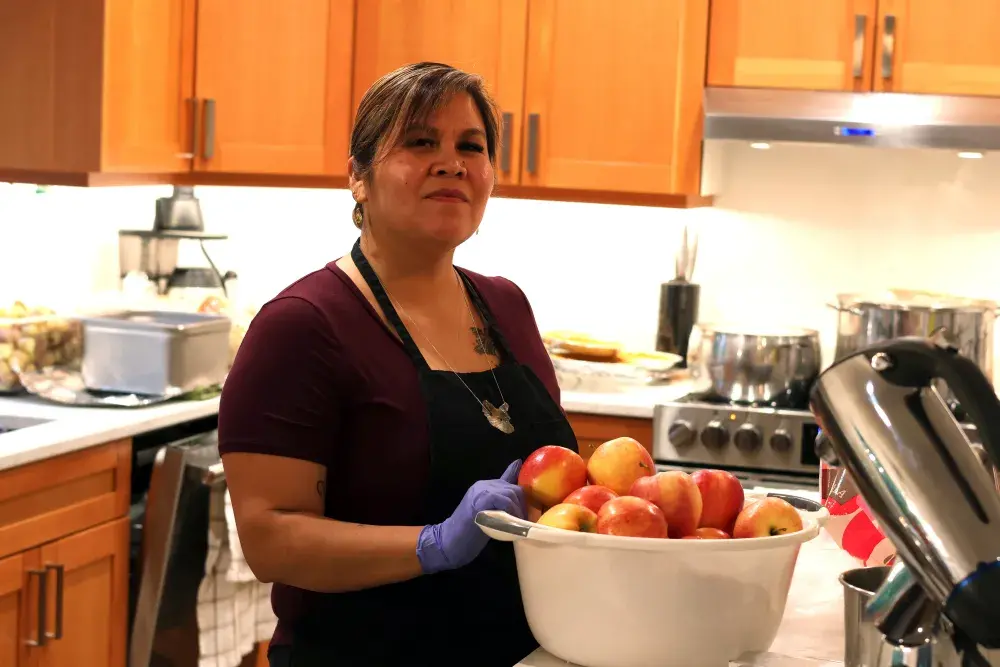Nuu-chah-nulth caterer Lil’ Star Frank took beef off her menu after the price of roast beef climbed to $90 for a couple pieces that would only feed about 15 people.
For potlatches, she needs to create meals for upwards of 500 guests, and lately, her spending at the grocery store topples $3,000 for an event of that size.
“Food… I can’t even explain. I feel like, is my catering even worth it?” she said. “The beef sure went up in price. Same with flour, we’d be lucky to get it for $10 a sack. Even vegetables, I can’t believe it, like $10 for a bag of apples?”
She says it feels like groceries have “tripled in price” and it doesn’t matter where you shop, from Quality Foods and Costco to No Frills and Super Store, everywhere is expensive – even Walmart.
Fueled by high import duties imposed by the United States and countermeasure tariffs by the Canadian government, grocery price inflation continues to outpace growth in the all-items Consumer Price Index (CPI), according to Statistics Canada.
Coffee has the highest product price increase on the Stats Can CPI tracker, month after month. The price of roasted or ground coffee climbed 34.2 per cent in October compared with October last year.
Tofino’s Common Loaf Bake Shop, known for providing some of the best value meals and drinks in the area, recently upped its price for a cup of coffee from $1.90 to $2.75 or $3.60 if customers ask for a takeaway cup.
Other items on the monthly CPI list to increase in October compared to last year were fresh or frozen beef prices (up 16.8 per cent), bacon (up 8.3 per cent), canned salmon (up 8.7 per cent), eggs (up 3.2 per cent) and lettuce (up 7.5 per cent).
“It shouldn’t be that much,” said Frank. “I rarely see stuff that’s on sale. Sometimes the rice is on sale for $7.”
Frank recently moved from Ahousaht to Nanaimo with her two daughters and three boys in care. She thought it would be cheaper relocating from a rural First Nations community to an urban hub like Nanaimo, but with her increased rent and cost of fuel, she says it’s not.
Her monthly grocery bill for nourishing her five kids is about $1,600. The average monthly cost of healthy eating for a family of four in Island Health is about $1,366, according to a 2022 report from the BC Centre for Disease Control.
“Homemade cooked meals and baked meals are probably what saves us. My daughter makes, or I’ll make, bread. My kids don’t eat store bought bread,” said Frank, who was the foods coordinator for Maaqtusiis Elementary School in Ahousaht.
“I know eating healthy is costly, but I’d rather buy more fruit every week for my kids than chips and chocolate and pop,” she continued.
Frank serves her kids smoked fish or jarred fish with rice or potatoes at least once a week as the “easy meal”.
“It’s going to be like a two-dollar meal if I have smoked fish and seaweed,” she said.
She’s also grateful for the muwač (deer) meat and other game meat she receives from family members.
“What is it going to cost us for eating muwač when the nation gives it to us?” she said.
“You think of our traditional foods, it’s so much healthier. Back in the day we didn’t have all the diabetes, the high blood pressure, the cancer, because we lived off the land. It’s so much healthier than buying meat with so much added to it,” said Frank.
Rachel (Dickens) Greening, a registered dietitian and certified diabetes educator for the Nuu-chah-nulth Tribal Council, re-iterates.
“Traditional food is always going to be healthier for Indigenous people, not just for nourishing our physical body but also our spiritual being,” said Greening.
“Traditional foods and harvesting, for many people it’s ceremony and a way of connecting to the land and connecting to our relations and our community through the reciprocity,” she said.
She encouraged people to amplify those “easy meals” of fish and rice in a cost-effective way by topping it with seaweed or adding fried onion or frozen peas.
“Onions are a great vegetable. They are inexpensive and so nutritious,” said Greening.
The price of onions dropped by 7.3 per cent this October compared with last October and frozen vegetables also decreased in price by 1.9 per cent, according to the Stats Can CPI tracker.
Frank's latest catering gig on Nov. 22 was a coming-of-age potlatch in Tla-o-qui-aht traditional territory on the west coast of Vancouver Island. Her menu was built around a dozen donated turkeys, donated deer meat and features lots of fish choices like baked salmon, cod and halibut.
“You have to have fish at a potlatch,” said Frank, who also bakes all the desserts from scratch.
She can be reached for catering requests at: lilstarfrank@hotmail.com.

